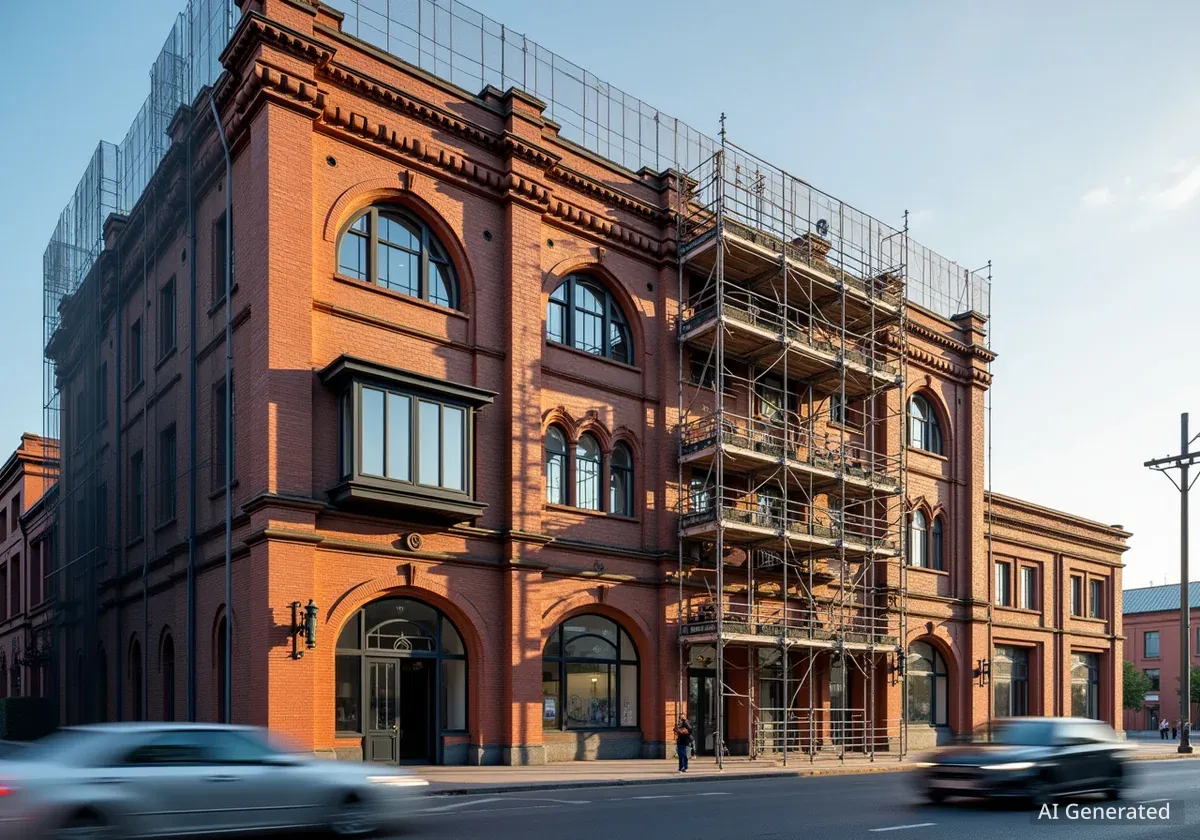A growing number of developers are turning old office buildings and industrial sites into modern apartments, a strategy known as adaptive reuse. This trend is driven by a surplus of vacant commercial space and a critical shortage of housing, creating a practical solution for urban revitalization.
In cities like Rochester, New York, developers are leveraging the solid construction of historic buildings and a variety of financial incentives to meet the demand for new living spaces, transforming the local real estate landscape one project at a time.
Key Takeaways
- Adaptive reuse is the process of converting old buildings, like offices and factories, into new functional spaces, often residential apartments.
- The trend is fueled by a post-pandemic increase in vacant office space and a national housing shortage estimated at 4.3 million units.
- Developers find it more financially viable than new construction, partly due to incentives like historic tax credits and brownfield cleanup programs.
- Projects in Rochester, NY, such as The Marblery and Innovation Square, showcase how this strategy revitalizes historic structures and meets community needs.
The Rise of Adaptive Reuse
The practice of repurposing existing buildings is gaining momentum across the country. Developers are increasingly looking to vacant offices, warehouses, and factories as prime candidates for conversion into residential units. This shift addresses two significant market challenges simultaneously.
First, the nature of work has changed, leaving a substantial amount of office space empty. Second, there is a severe shortage of housing. According to the NAIOP Commercial Real Estate Development Association, the United States will need an estimated 4.3 million new housing units by 2035 to meet demand.
Why Repurpose Instead of Building New?
Building new residential properties from the ground up can be prohibitively expensive. Joel Barrett, managing director of the Rochester-based real estate firm 43 North Real Estate, explained that recouping costs on new construction is difficult in the current market.
“Generally, with a new residential construction building, unless you’re doing some type of affordable housing, it’s very difficult to recoup costs,” Barrett said. “So post-COVID you’re seeing a lot less — especially in this marketplace — of new construction residential apartments.”
Adaptive reuse offers a more financially sound alternative. Developers can often acquire older, sometimes dilapidated, buildings at a lower cost. “We’ll buy things that no one else would because they’re falling apart,” Barrett noted. “We get quite a bit of value on the buy side because essentially we’re buying shells.”
Financial Incentives and Quality Construction
One of the primary drivers of the adaptive reuse trend is the availability of financial incentives that are not offered for new construction projects. These programs can significantly offset renovation costs and make complex projects feasible.
Key incentives include:
- Historic Tax Credits: Federal and state programs provide tax credits for the certified rehabilitation of historic buildings.
- Brownfield Cleanup Programs: States like New York offer tax credits for redeveloping contaminated properties, turning environmental liabilities into community assets.
- Local Grants and Loans: Cities often provide their own funding mechanisms to encourage the renovation of underutilized buildings.
Barrett emphasized the importance of these programs. “It takes a village of incentives, loan programs, lots of capital tax credits, pilots, etc., to get these projects done,” he said.
Built to Last
Another key advantage is the quality of older buildings. “The quality of construction from prior eras is really valuable,” said Barrett, highlighting that the robust structures of historic industrial and commercial buildings provide a solid foundation for modern residential conversions.
This combination of high-quality raw material and financial support allows developers to create unique living spaces that blend historical character with contemporary design and amenities.
Rochester Projects Showcase Success
Several projects in Rochester, New York, serve as powerful examples of adaptive reuse in action, demonstrating how the strategy can revitalize neighborhoods and preserve local history.
The Marblery at 222 South Avenue
A 7,500-square-foot brick building constructed in 1858, once home to Hebard Marble Works, has been transformed by Barrett’s team. Now called The Marblery, the three-story structure contains four modern apartments and commercial office space.
A Complex Financial Puzzle
To make the project viable, Barrett's team secured multiple layers of funding. After getting the building placed on the National Register of Historic Places, they utilized enhanced state historic tax credits, a Small Mixed-Use and Commercial Renovation (SMUCR) loan from the City of Rochester, and an electrification grant to convert the building to high-efficiency electric heating and cooling.
“On this project, even though it was 7,500 square feet and it took us a long time to do all this, we were able to right the ship,” Barrett said, reflecting on the project's success.
Innovation Square on South Clinton Avenue
Gallina Development Corporation took on an even larger challenge with Innovation Square, the former 30-story Xerox Corporation office tower. The nearly 580,000-square-foot building, which was almost entirely vacant, is now a vibrant living and learning community for college students, alongside modern office spaces.
Evan Gallina, a partner at the firm, pointed to market forces as a key driver. “Construction costs have increased significantly enough that building new is often prohibitive,” Gallina explained. “Reuse is cheaper than building from the ground up, and that’s where people find value.”
The project has successfully attracted new commercial tenants, including the law firm Phillips Lytle LLP, which moved nearly 70 employees into a new 19,769-square-foot office in June. “We took two towers that were virtually empty and now they’re mostly full,” Gallina said. “We’re proud of what we’ve done.”
Future Projects and the Importance of Teamwork
The success of these projects is paving the way for more ambitious conversions. Barrett’s team is now embarking on its largest adaptive reuse project to date: transforming an 84,000-square-foot former warehouse on a brownfield site in Canandaigua into a 51-unit apartment building.
The building at 10 Chapin Street had sat vacant for years, with three previous developers failing to move forward due to its complexities. “There were complexities in every single scenario and every single aspect of the project, but we’re just about to start construction,” Barrett said.
He stressed that these achievements are not the work of a single person but require a large and skilled team. He credits a network of about a hundred professionals on any given project, including environmental and real estate attorneys, architects, engineers, and historic consultants.
“Sometimes the developer gets all the credit, but I am supported by about a hundred different people on any project,” Barrett stated. “I think one of the benefits of doing adaptive reuse here is that we have design professionals and legal professionals who are probably some of the best in the country.”





